The Best Ice Climbing Gear of 2023
Climbing and Yahoo may earn affiliate commissions on some items promoted through links in the article below. This article originally appeared on Climbing
Long gone are the days of hemp ropes, hobnailed boots, and chopping steps up ice faces. Today's ice climbing gear is highly engineered, refined, and more dialed than ever. Even so, simply surviving our season of abuse was no small feat. The pieces below made the final cut.
How We Test
Our testers boast an impressive resume, from young guides to sage elders of the sport with first ascents in Pakistan and Patagonia. They ranged in age from 25 to 59, from guides to professional alpinists to everyday senders. With hundreds of years of collective ice climbing experience destroying nearly everything on the market--or not on the market--for the last 30-plus years, they put the 80 products in this year's pool through the paces. They hammered these products on the frozen escarpments of Colorado, Wyoming, Montana, Canada, and Alaska--and they’re not exactly a delicate crowd. The finalists we selected represent the rare confluence of peak performance, durability, and value.
Tester Stats
Number of testers: 6
Number of products tested: 80
Number of vertical feet: 10,000+
Meet Our Lead Tester
Maury Birdwell
Maury is an attorney and climber based in Boulder, CO. He has had the good fortune to climb and establish routes around the world, his favorite part of which is the communion it provides with his partners and the heroes who came before him. Some highlights include freeing the original Royal Robbins line on Mount Hooker in the Wind River Range with Jesse Huey (Original Sin, 5.12+), the first free ascent of Armageddon (5.12+) on the North Howser Tower in the Bugaboos, Canada, and setting the car-to-car speed record for climbing (solo) the Diamond of Longs Peak. His work focuses on outdoor business development, and in 2012 he co-founded the Honnold Foundation with Alex Honnold – perhaps his greatest personal 'send' to date.
Reviews: The Best Ice Climbing Gear of 2023
La Sportiva G-Tech Boots ($769)
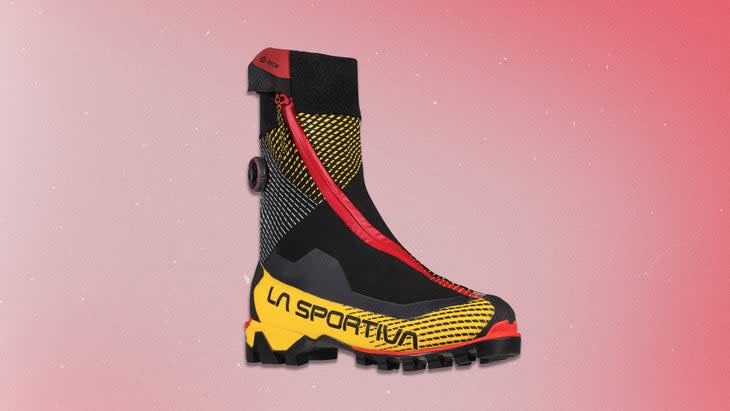
Weight: 620 grams
Size range: 38-48 (half sizes)
Lots of brands make mountain boots, but few do it well. La Sportiva continues to deliver. The G-Tech is an ultralight boot with lightweight insulation, so it won't be your main workhorse for colder temps or when you anticipate standing around belaying for hours. However, in moderate conditions where movement is more continuous than not, it’s a standout home run. Its agile, low profile enables the most precise foot placements on techy ice and mixed pitches, and the carbon insole walks better than any other ice boot in our quiver. Overall, The lightweight, svelte construction elicited a comparison to putting on rock shoes after climbing in approach shoes--so much so that by the end of a trip to Cody, Wyoming, our testers were fighting over who got to wear them. Other highlights: the external BOA fit adjustment system that's effortless to operate in gloves for on-the-go adjustments. The wraparound, full-coverage gaiter provides a huge warmth return for its weight (and frankly is a must have for any mountain boot these days as far as we're concerned).
Best-for: A light 'n fast boot that climbs like a Testarossa.
Scarpa Phantom Tech Boots ($799)
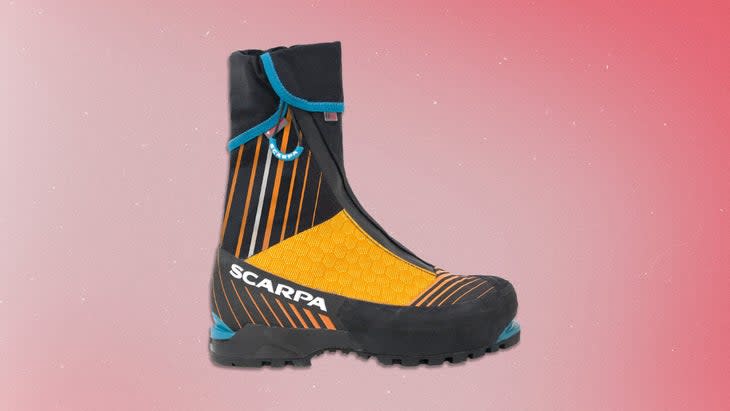
Weight: 1050 g
Size range: 38-47 (half sizes), 48
Those Italians sure know how to make footwear, from rock shoes to mountain boots. Many have tried to rival them, but there must be something about 100 years of institutional knowledge that's tough to beat. If we're allowed one boot for the broadest range of icy cragging or alpine missions below 5000 meters, the Phantom Tech is our choice. The carbon-fiber insoles walk remarkably well for a mountain boot, with a more forgiving width than other mainstay competitors, and the flexible, Primaloft insulated upper allows ankle articulation on tricky moves while still providing solid support when frontpointing. The integrated, waterproof, breathable schoeller gaiter--now the standard for alpine footwear--adds significant warmth without bulk, and the offset zipper prevents pressure points when walking.
Tightening boots in the right places is always a finicky affair, but the quicklace system on both the Tech and the 6000 eases this process with a cordlock over the midfoot that holds tension separately as you lace the upper. Something especially handy when wearing gloves, since numbing uncovered fingers to tighten boots right before a tough pitch is never a great prelude to leaving the ground.
Best-for: A favorite all-arounder
Scarpa Phantom 6000 Boots ($1,049)
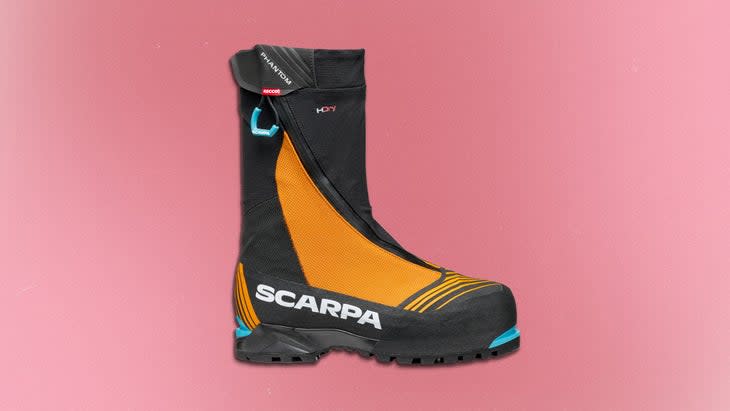
Weight: 1320g
Size range: 38-49 (full sizes)
There's just no beating a double boot for multi day adventures and cold climates. For those with poor circulation or for whom higher elevations and latitudes are calling, the freshly updated Phantom 6000 continues to build on its predecessors' success. Scarpa also updated more than just the aesthetics: they rethought traditional double boot design entirely. Scarpa's designers upgraded to a combination of Primaloft insulation and aerogel (the world's most insulating material--the same one first fielded in the Phantom Tech). They also remapped the insulation, adding it where it's needed most. This meant shifting it away from the ankle and towards the actual foot and toes. The result is a liner bootie that feels more like a neoprene sock on the upper half. It has better walkability and still-excellent climbing performance, yet the bootie and shell separation goes unnoticed. After a few minutes of wear, the Phantom 6000 feels like a single boot thanks to a dialed fit that eliminates slippage between the inner and outer shell. For all but the hardest climbing, the extra weight and volume are barely perceptible, and they require practically no break in. Ours went out of the box for a 36-hour test on Alaska's Mount Huntington, and climbed up to WI5, M6, and "5.10" with no complaints. For previous users of the 6000, we did note the new version has a roomier fit, so you may want to double check your size before committing.
Best-for: Your go-to for multi-day trips and very cold temps
Petzl Dart Crampons ($229)
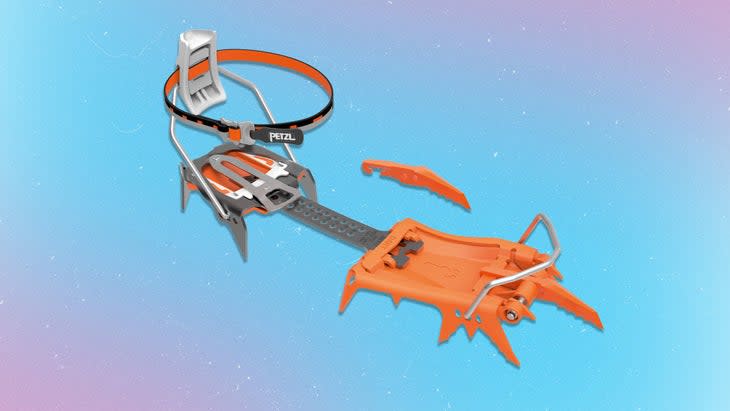
Weight: 820 g
Size range: one size fits all
I was beyond wary when I heard that Petzl was messing with my long standing go-to Dart crampons, and even more so when the brand revealed it was ditching the dedicated, single piece monopoint for a modular design--combining the monopoint Dart and dual point Dartwin into a single offering. Why fix what wasn't broken? There's no denying that replaceable frontpoints extend the life cycle, but still, I was skeptical heading into their first outing.
They initially felt a bit heavier in hand (only a few grams in reality). And I was nervous about all the screws and interchangeable parts as I headed into the mountains (extra pieces to lose and break). But after hundreds of pitches on ice, rock, and snow, I forgot any misgivings about durability or performance and became a convert. They climb like a dream. The legendary Chalet steel points penetrate ice and hold their edge impressively long. The secondary points are placed far enough back not to interfere with precise front point placements, while still engaging when kicking into proper ice for extra stability. With just a couple minutes and an allen wrench, you can swap worn out front points and switch between mono, dual, and dual-offset configurations. The mono versus dual frontpoint debate still rages, so it’s nice to have a crampon that offers flexibility to explore each. Plus, it eased my packing for trips to the Alaska Range, where I could configure them in the tent for specific objectives: offset dual points for the predominantly steeper snow and neve of Peak 11,300 and mono points for the blue ice and rock steps of Mt. Huntington's Colton Leach. For the ultimate alpine tweakers, you can even swap newmatic (i.e. strap) bails and a fully aluminum heel piece to go ultralight. The modular configuration and interchangeable bail and heel systems make the Dart an incredibly versatile bang for your buck that climbs as good or better as its trusted predecessor.
Best-for: A fully modular crampon system from one of the most reliable names in the biz.
Petzl Nomic Ice Tool ($299) and CAMP X-Dream ($279)
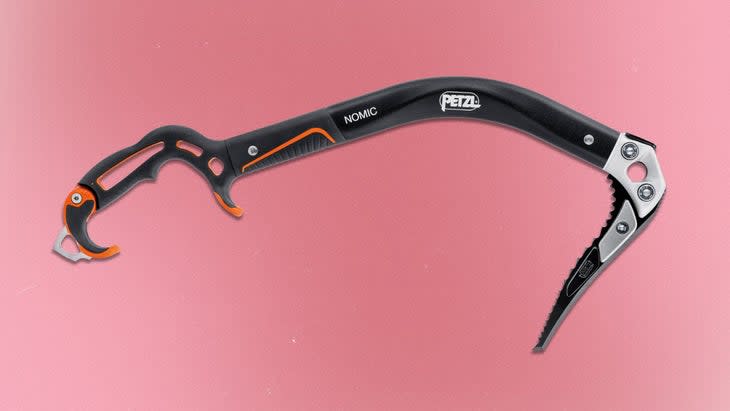
Petzel Nomic Weight: 585g
Petzl Nomic Size range: one size, S-M-L grip adjustments
CAMP X-Dream Weight: 595g
CAMP X-Dream Size range: one size, multiple grip adjustments
Petzle Nomic Ice Tool CAMP X-Dream
I've been using the Nomic for over a decade. As with the Dart, you can't beat Petzl's long-established craftsmanship and steel quality. Petzl also knows not to ruin a good thing, and though the brand has updated the Nomic a few times since its release in 2008, Petzl has never disrupted its fundamental function. At the end of the day, it's an ice tool with a perfectly balanced swing and shape that performs with equal aplomb on moderate ice to steep mixed angles. When Conrad Anker teed me up for a go at the classic and notoriously challenging Alex Lowe testpiece, Come and Get It (WI6, M7 traditional), I didn't hesitate to select the trusty Nomic from my quiver. The precisely machined picks swing and hold into ice effortlessly, and the artfully curved shaft is remarkably stable when balancing on rock edges. The only other viable competitor to the Nomic is the beefier and comfier C.A.M.P. X-Dream, which also boasts a well balanced swing, along with a number of micro adjustments to the handle and trigger rest to accommodate different hand sizes. That said, the lower profile handle on the Nomic adapts better to snow-plunging--plus, superior hammer and adze options give it the edge.
Petzl Best-for: A tried a true jack of all trades.
CAMP X-Dream Best-for: A strong competitor to the Nomic with top notch ergonomics.
Black Diamond Spinner Leash ($60)
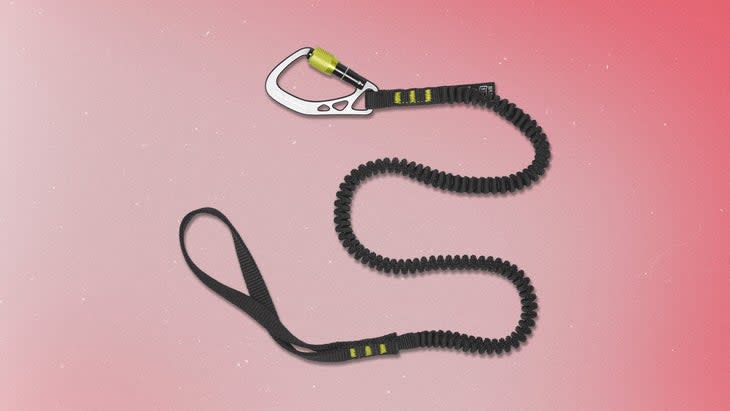
Weight: 90g
Size range: one size
Rule #1 in ice climbing: "The leader shall not fall." If there's a Rule #2, it's: "Don't drop your ice tools." Since the advent and domination of leashless tools (you young whippersnappers may not know we all used to climb with our arms strapped to our tools), the one downside has been that between all the switching, matching, and shouldering, you could simply drop one of only two things allowing you to hold onto the mountain. In the Ouray Ice Park, you'd have to fish it out of the river, or worse, injure someone below. On multi-pitch routes, it means the day is over; and in the mountains it could be a deathly mistake.
The early DIY solution was connecting one's tools to your harness with webbing or slings. I even built my own early innovation by scrunching webbing onto elastic cord, ordering a marine supply swivel, and having my mom sew the entire rig together (mom appreciation shout-out). Climbing brands quickly caught on and started churning out their respective versions, each with their various pros and cons. Enter the Black Diamond Spinner Leash. It combines two of our most critical desires: a swivel at the waist to prevent endless tangles, and miniature lockers so it doesn't unwittingly unclip and violate its singular duty. Most comparable products have caught onto the swivel integration, essential to prevent tangling as you switch and match tools, but most still use a non locking carabiner to clip to the tool. Considering that the point of this particular piece of equipment is to provide a failsafe, those extra grams are indispensable.
Best-for: Keep your friends close and your ice tools closer.
Blue Ice Aero Screws ($69)
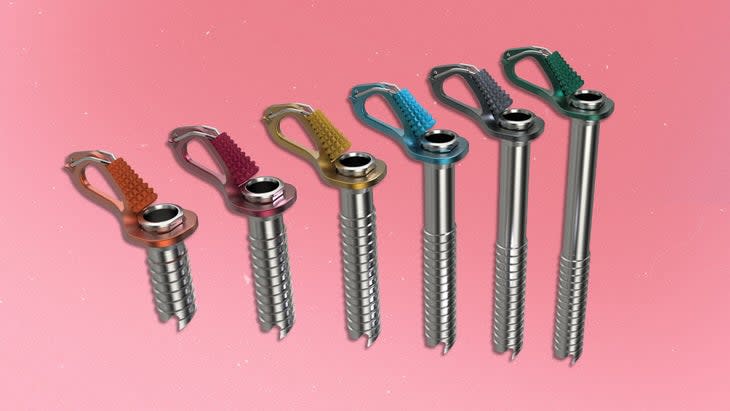
Weight: 63g, 76g, 90g, 100g, 111g, 121g
Size range: 7cm, 10cm, 13cm, 16cm, 19cm, 22cm
Blue Ice is a brain trust of outdoor gear elders from across the industry, and leading the product team is climbing legend Bill Belcourt. A man who's been at the cutting edge of climbing equipment--and ascents-- for decades, Belcourt boasts an equally impressive resume in paragliding. He's used this varied experience to cross-pollinate from an airborne sport where every gram counts, to bring innovation to a space that often follows the same old playbook.
Last year, Blue Ice shocked the market with the Aero Lite, an aluminum ice screw which clocks in at nearly two thirds the weight of other aluminum screws thanks to its wider bore and thinner walls. But while aluminum is wonderfully light, it comes at a compromise of durability and performance.
So for its latest paradigm shift, Blue Ice applied the same weight-saving technology to steel. The result: The Aero, a fully steel ice screw that's as lightweight as competing aluminum ice screws: a 13-centimeter Aero weighs 90 grams vs a 13-centimeter Petzl aluminum screw at 91 grams! That's right--you can now have a shockingly light rack of ice screws with none of the compromise. Even on big objectives in Alaska where ounces mattered and aluminum screws would have been the de facto choice, our testers picked the Aero. Plus, the wider bore of the Aero (and Aero Lite) makes it easier to line up V threads and to fish out ropes, which was a welcome margin for our exhausted team descending Mt. Huntington's dozens of rappels.
Best-for: From the ice park to the mountains, durability and lightweight without compromise
CAMP Rocket Screws ($59)
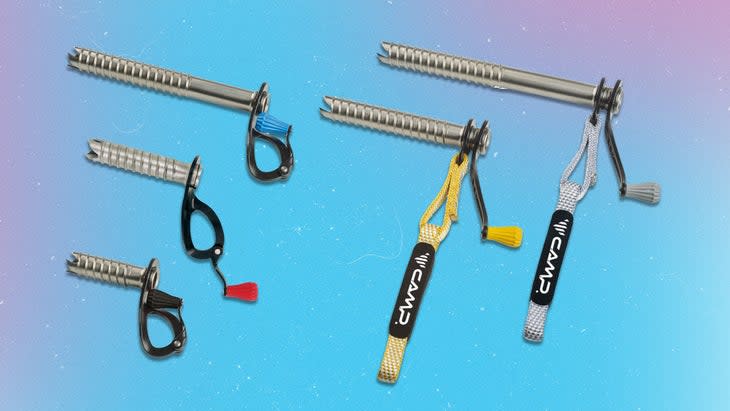
Weight: 84g, 94g, 116g, 130g, 142g, 155g
Size: 7, 9, 13, 16, 19, & 22cm
CAMP has been making a name for itself by pushing category limits while keeping costs low. We were delighted that the best placing screw in the test field was also the cheapest. Manufacturers have been playing with tooth count, angles, thread bevels, and diameters for years. But with this four-tooth design and reverse angle thread specs, CAMP nailed it. When starting a placement, the teeth grab the ice like high school sweethearts on the dance floor. Typically, placing screws without some bodyweight oomph to start them is a chore, but reaching around with no leverage to drive a Rocket on the backside of an otherwise thin, sunbaked pillar was a snap--and a relief. While the full chromoly steel Rockets may not be the lightest choice for huge objectives when every gram counts, they're our top choice as a cragging and hard-lead workhorse.
Best-for: A bang-for-your-buck workhorse that practically places itself
Hyperlite Mountain Gear Prism Screw Case ($99) and Crampon Bag ($59)
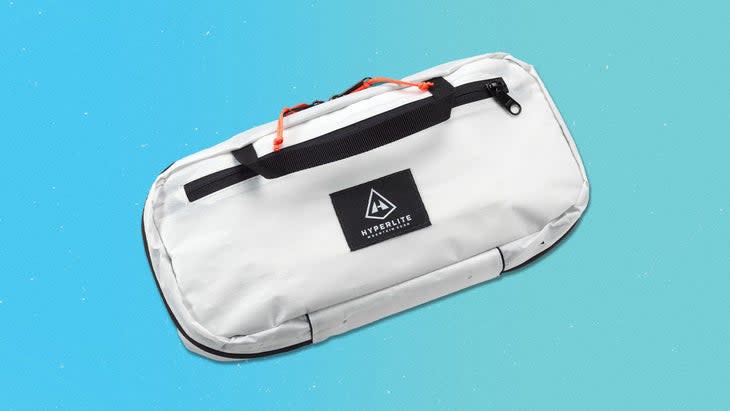
Weight: 153g & 113g
Size range: one size
Dimensions: 30.1cm x 15.2cm x 6.4cm & 33cm x 10.2cm x 7cm
Exploding a pack full of loose gear is fine at the sunny sport crag, but the base of ice routes is often steep, narrow, and snowy, making a disorganized kit very aggravating. Most brands offer some form of the fold-up, slotted burrito case to keep screws sharp and organized, but Hyperlite's is the first we've used that fully zips closed. It's a simple fix, but is dramatically more efficient--no more juggling to keep screws in place until the burrito strap is tightened. It's also easy to throw in a few extra screws or accessories (like files). The brand also offers similarly ingenious solutions for crampons. (Strapping them to the outside of your pack is always a decent option, but on involved approaches there's the concern of your pack's external bungee working loose and the crampons mysteriously disappearing. Hyperlite's Prism Crampon Bag makes it easy to toss your crampons inside the pack without worrying about punctures or snags. Both look understatedly great in the white dyneema, and are super lightweight and low bulk so you can look dialed and stylish.
Best-for: Clean and lightweight ways to protect your sharp investments and keep them organized in your bag.
Petzl Nano Traxion ($100)
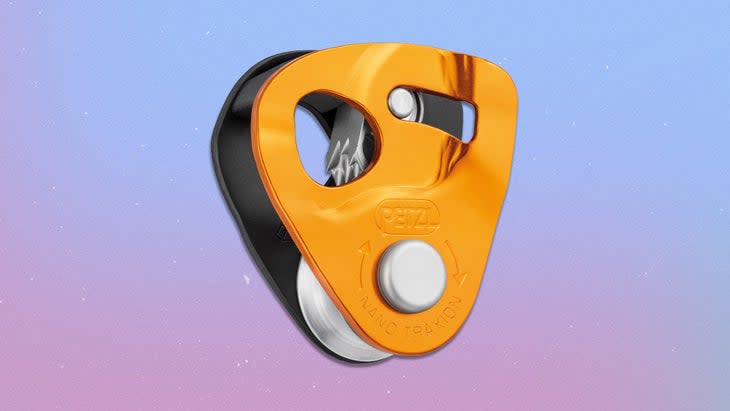
Weight: 53 g
Size range: one size fits all
You should never go anywhere without a Nano on your harness. Full stop. Petzl took its long standing favorite Micro Traxion rope capture pulley and reduced it from 85 grams to just 53. At that weight, for such a broad range of uses--rescue, rope management, emergency ascending--you just can't afford not to carry one. It’s worth noting that to achieve that feathery weight, Petzl eliminated the Micro's lockout feature into open pulley mode, but unless you're a true bigwaller, this is unlikely to matter. Whether you're winching your partner out of a crevasse fall, protecting an unexpected (or planned) simul climbing section, or simply easing the strain of pulling rap lines, the Nano is simply indispensable.
Best-for: An indispensably versatile device every climber should carry.
Edelrid Pure Slider Carabiner ($20)
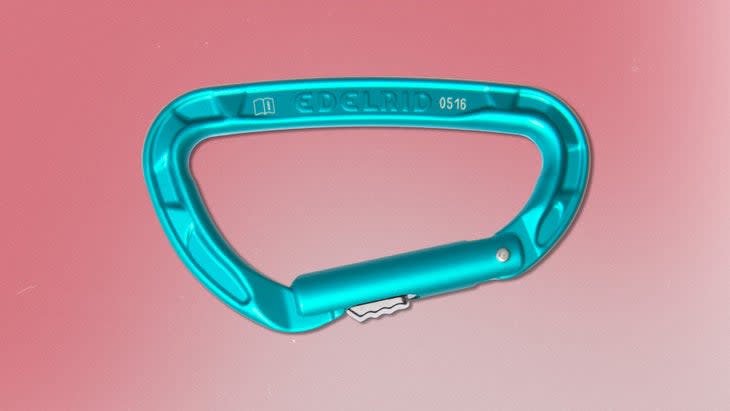
Weight: 45g
If you want to attach your Nalgene to the outside of your backpack, locking carabiners are essential (kidding). Strangely though, climbers often favor large, bulky locking carabiners when there are actually only a few key kinds of anchors where a large 'biner with a wide gate opening is necessary . For most applications--think belay devices, personal tethers, or critical gear clipped onto your harness--the added gate security of a locking mechanism is key, but size is irrelevant. The Pure Slider is a trimly packaged autolocker (45 grams), with a sliding gate mechanism that's easy to operate with gloves on. Plus, when it comes to icy endeavors, freezing has always been a pitfall of traditional screwgate lockers; the simpler mechanism of the Pure Slider invites less precipitative material and at worst a few hot breaths free it up every time. Meanwhile, the gate is low volume and its angles are obtuse enough that it slides completely through a Nano Traxion's clip-in point--a match made in heaven.
Best-for: A lightweight, versatile locker that won't slow you down.
Black Diamond Vision airNET Harness Recco ($169)
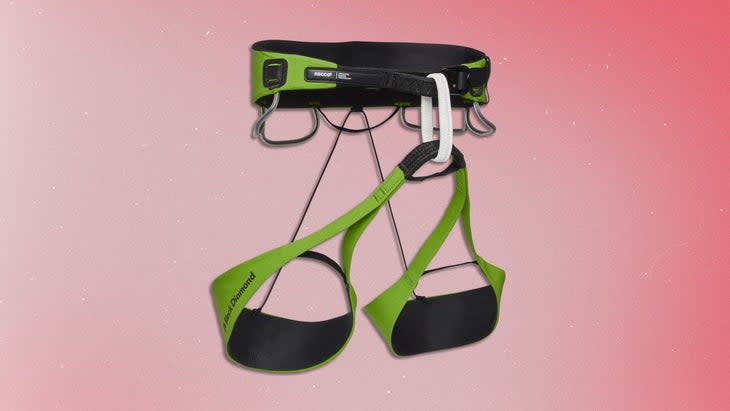
Weight: 255g
Size range: S-XL
The best harness designers have realized a simple truth: comfort is not about slapping some padding onto nylon, but about thoughtful, conscious ergonomics designed around the human form. The original airNET was a superlight and trim comp harness designed for Adam Ondra's Olympic dreams. But "superlight" and "trim" serve another discipline quite well, and Black Diamond VP of Product and climbing-lifer Kolin Powick quickly saw the potential for a broader application. They added a 70 denier nylon layer that increases abrasion-resistance sevenfold, and is water-resistant and non absorbent. The same airNet technology that expands load bearing construction across the width of the waist and leg loops is remarkably comfortable, even in comparison to beefier, padded competitors. Some of our favorite features include four molded gear loops, ice clipper slots, and a more forgiving fit for those of us who still cast a shadow standing sideways. Our lead tester wore it as his quiver-of-one all year long--from sport climbing 5.13s to alpine missions in Bozeman and the Alaska Range.
Best-for: A streamlined, lightweight harness that's a true quiver killer.
Edelrid Starling Protect Pro Dry 8.2mm Half Ropes (from $220)

Weight: 44 g/m
Size range: 60m & 70m
Double ropes are usually a last choice for our testers. They're prone to tangling, require way more management, and are less durable over sharp edges. But Edelrid's Starling Protect half ropes overcome that massive bias. The Aramid sheath helps preserve integrity of the skinnier cords, and also adds a bit of stiffness that seems to make the rope less tangly than traditional double rope setups--think al dente pasta. We won't be packing them over our beloved single rope setup every day, but on missions where we'd normally avoid double ropes, the Starling Protects make a killer choice--and that's saying a lot with this salty crew.
Best-for: Half ropes that actually make me want to use half ropes
Sterling Xeros Aero 9.2mm ($149-389)

Weight: 56g/m
Size range: 40, 60, 70, & 80m
Seeing as ice climbing involves a lot of time spent around a literal phase state of water, dry ropes are a necessity. There is no avoiding some amount of water contact as ropes slide across an icy surface (Google the physics of ice and its surface liquid--it's fascinating). Traditional dry treatment is always applied in some fashion once a rope is fully manufactured; it's effective, but it eventually wears off.
That's where Sterling's Xeros technology comes in: each individual fiber is actually water resistant, making the entire cord fundamentally dry from its core. We found that our Xeros Aero walked the talk, maintaining dryness in ice and snow even after multiple rock pitches in Boulder's rough and abrasive Flatirons that would have marked the end for other dry treatments. The rope was more durable too, since dry treatments make fibers more slick and less prone to snag and wear--as of now, our sheath is still fuzz- and wear-free.
Best-for: A workhorse rope that will stay dry and durable.
Grade VII Equipment Haul Pack (from $255)
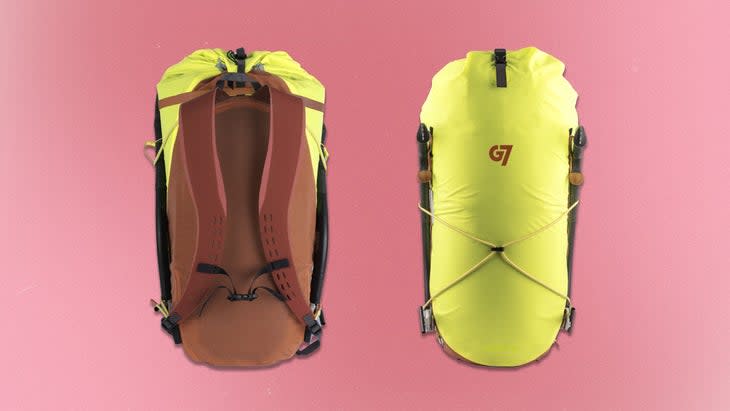
Weight: from 1 pound
Size range: 22L, 36L, 55L
G7 came into the climbing market hot in 2018 when they shattered the portaledge standard with their innovative, inflatable POD, which weighs just three and a half pounds. Now they're breaking boundaries in the realm of backpacks. The brand's team has developed a proprietary 205×235 denier Thermoplastic Polyurethane (TPU)-coated fabric which is much lighter and more supple than traditional PVC-coated haul bags. They combined that with sleek design elements like low profile straps sourced from an industrial Japanese suede material that carries well and has minimal bulk, and inner foam liner that minimizes hard points (which lead to friction and wear). All told, the result is a pack that's alpine-lightweight (under 2 pounds versus 5+ pounds) but haul bag-durable. You can even strip down the various external accouterments (including the top strap, ice tool carriers, wraparound dyneema bungee, and waist strap) to customize it for your mission. In a testament to holistic design, the Haul Pack has no rigid frame components or thick waist belt padding, but is still extremely comfortable on your back. Plus, the thin internal pad liner is a nice bonus to protect your laptop while using the pack as a carry-on en route to life's next adventure. After getting hauled up a few laps on El Cap, over 2,000 feet in the Black Canyon, and a blitz to the Alaska Range, ours still has no signs of wear.
Best-for: Alpine climbing weight + haul bag durability
Hyperlite Mountain Gear 2400 Ice Pack ($359)
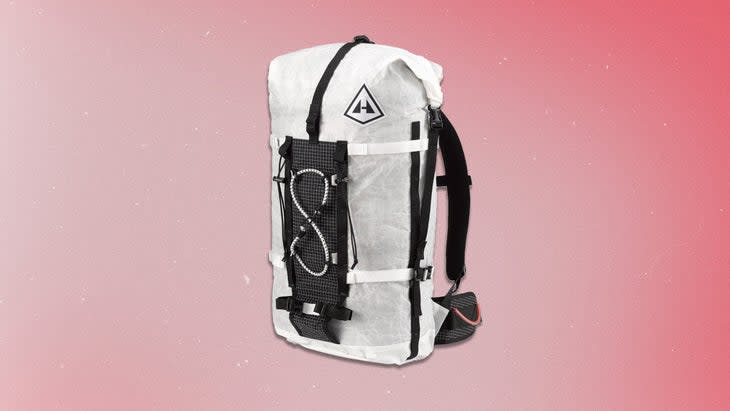
Weight: 2.14 lb
Size range: S-XL
Dimensions: 40L
The necessities of a good pack are nearly universal: carrying ability, ease of packing and access, and ability to fit it all while being as lightweight as possible. As with many things in life, the simplicity and elegance of design comes out on top--and on those maxims, Hyperlite shines. The cavernous 40 liter, Dyneema compartment is easy to pack without awkward tapers leading to dead spots. It fits a full 80-meter rope, harness, crampons, food, water, layers, and room for more. Add in a few key side and top straps, ice tool slots that hold modern tools securely, and there you have it! Many roll top packs come out cumbersome, bulging open as you try to close, but Hyperlite solved that issue by integrating a velcro closure strip inside the lip. Another fantastic touch: the velcro seals the top against snow and debris without having to completely open and close the roll top every time you need to reach inside for a screw or glove while at the base of a route. What's more, the Ice Pack achieves all this at a scant 2.14 pounds. That said, it still carried the best of every pack we got our hands on (don't worry, the lightweight aluminum stays, foam back panel, and padded hip belt can all be removed to shed pounds for climbing). The Ice Pack's design is already a bit bulkier than an ideal climbing bag, so our preference is to keep it cushy and dump everything in for a day in Hyalite Canyon or Cody without being choosy. One odd choice is the large, hardware style bungee cord for holding crampons on the back – we'd suggest removing this for some lightweight bungee from your local climbing shop for a couple bucks to streamline the pack and save some weight.
Best-for: Don't be that guy--stay organized in style
Petzl Meteor Helmet ($89)
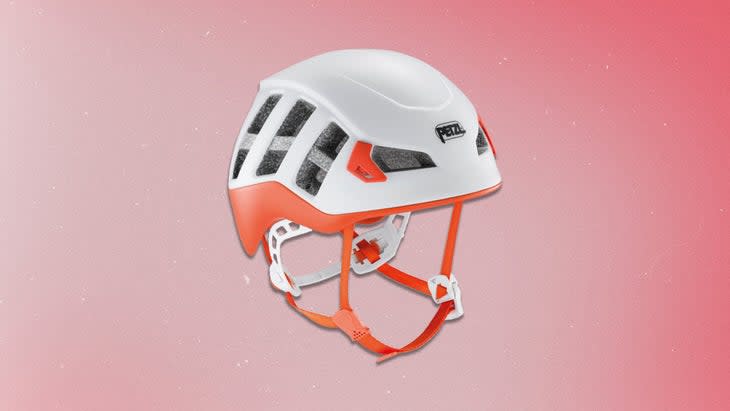
Weight: 240g
Size range: S/M, M/L
There are a lot of perfectly good climbing helmets out there, with the usual features and certifications--typically ranging from superlight-but-fragile to nuclear-indestructible-but–heavy. The Meteor mixes the best of both worlds. It isn't the lightest helmet on the market, but at 240 grams, it's damn close. Most notably, those extra grams earn your noggin added coverage on the back and sides, and it's the first CE-certified helmet for ski touring--a common activity to pair with ice climbing. It sits well and felt no more obtrusive than any other similar option. Plus, it held up well to bumps from falling ice, tossing around backpacks and truck beds, and checked airline baggage travel without visible dings. Helmets are mandatory equipment for ice and mixed climbing, so tacking ski touring coverage on as well makes this choice--ahem-- a no-brainer.
Best-for: Climbing, mountain, and ski coverage all-in-one
Showa Temres 282-02 Gloves ($23)
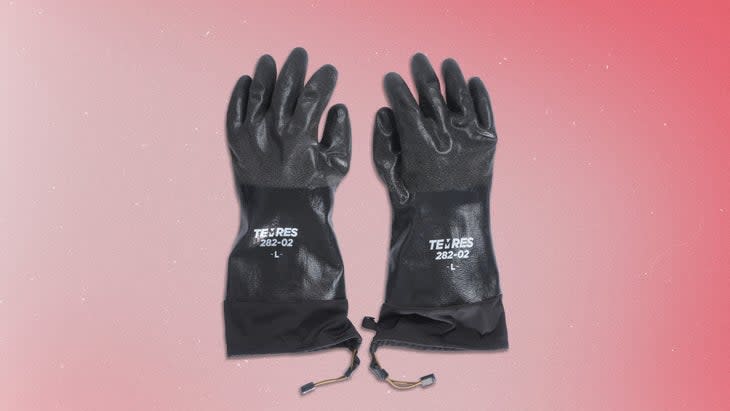
Size range: M-2XL
Climbing is known for borrowing good ideas, and when it comes to keeping your hands warm, dry, and dexterous, the Japanese fishing industry has a winner. Alpine guides have been wearing Showa's "smurf" glove (so called for its bright blue color) for a few years now. The 282 is just a simple, single layer of polyurethane coated knit material, which is totally waterproof and impressively nimble for handling screws and manipulating tools on tough pitches, paired with a fleecy liner. But the one improvement climbers have hoped for was a cinchable gauntlet to seal them off from snow. Some have even sewn them on themselves. Voila! Showa answered with the 282-02, keeping the same seamless construction of the original with a factory built gauntlet. It's easy to spend upwards of $100 on Gore Tex-lined, reinforced this-and-that, but for the price and performance, these Showa gloves are a must-have for everything from wet pitches in Hyalite Canyon to 30-plus hour nonstop pushes in Alaska. They tend to fit small, so we recommend ordering on the larger side.
Best-for: Unbeatable dexterity, waterproofness, and coverage at a fraction of the price of traditional "ice climbing gloves."
Black Diamond Torque Gloves ($60)
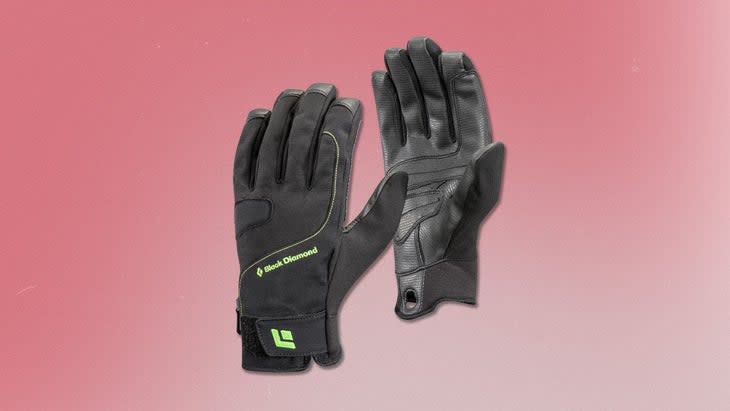
Weight: 71g
Size range: XS-XL
Will Gadd once said, "Bring spare gloves, lots of them." Whether its big peaks in Patagonia or cragging hard mixed lines at Vail, you'll find a pair of Torques in our pack. Carrying uninsulated and non-waterproof gloves may sound counterintuitive for a sport predicated on the cold, but it’s precisely those attributes that allow the Torque to shine on technical, high output pitches, where those seeming drawbacks translate to agility and breathability. Black Diamond has tweaked the Torque periodically since its release over 15 years ago, but the core attributes have remained the same: a thin and dexterous construction, with a sticky palm and TPU coated knuckles to protect and insulate from contact with the elements. The grippy frontside helps hold tools when you're pumped, and even rock climbs surprisingly well for those mixed moves when shouldering a tool makes more sense. Seams are offset from fingertips so you can nimbly manipulate ice screws and hardware, and were removed from the pommel side of the pinky entirely for more comfort when hanging on your ice tools. Any time the temps are above the low teens (or "high negatives," for our Northern readers), or the moves get beyond vertical, a pair of Torques should be any ice or mixed climber's preference.
Best-for: Lightweight must-haves for every mixed afficionado
Patagonia Das Light Jacket & Pants (Jacket $329, Pants $299)
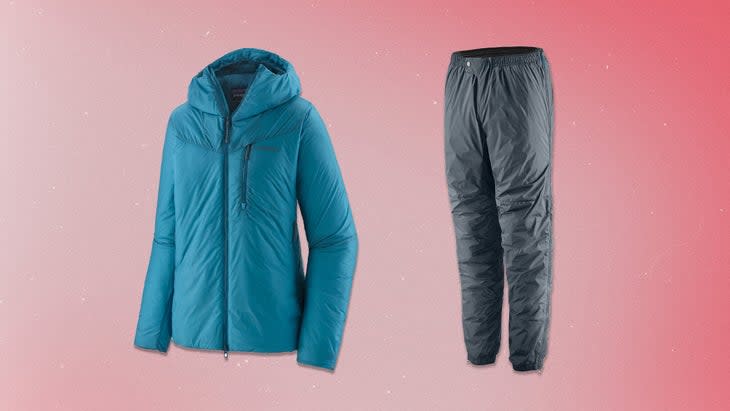
Weight: Jacket 11.3 oz, Pants 11 oz
Size range: XS-2XL
Men’s Jacket Women’s Jacket Unisex pants
Thirty years after its launch, Patagonia's iconic synthetic puffy jacket has become a household name. But, while it's incredibly warm, it's notoriously bulky and hard to pack. A few years ago, the company's head climbing category tester and alpine legend Kelly Cordes gave designers a greater challenge: get the DAS Parka below 20 ounces. They delivered, and the DAS remains a mainstay choice for bitter days, big objectives, staying warm at belays, and trudging out summit ridges.
But they didn't stop there. Enter the DAS Light, which is eight ounces lighter than the DAS. How? For starters, it utilizes a lighter layer of PlumaFill insulation (vs the DAS' Primaloft), which makes it easier to stuff down and clip to your harness. Perhaps notably, the insulation is quilted on the inside, between the liner fabric and an internal scrim. This keeps the insulation in place without constraining it (translation: better loft) and without creating external stitch holes where heat can escape. Not only does that equal more weight and material savings, but the seamless outer shell is more impervious to wind and water seeping through. The result is an 11 ounce jacket that provides surprising warmth for moderate conditions or those shorter belays bringing up the second.
Bonus: you can pair the jacket with the new DAS Light pants,which have full zip sides that make donning and ditching a breeze, even in full crampon-and-harness battle rattle. Combining puffy pants and a jacket (even the "light" ones) is far warmer than drowning yourself under massive puffy jackets alone. The whole is truly greater than the sum of its parts.
Best-for: Head to toe warmth for all conditions
Arc'teryx Gamma MX Pants ($300)
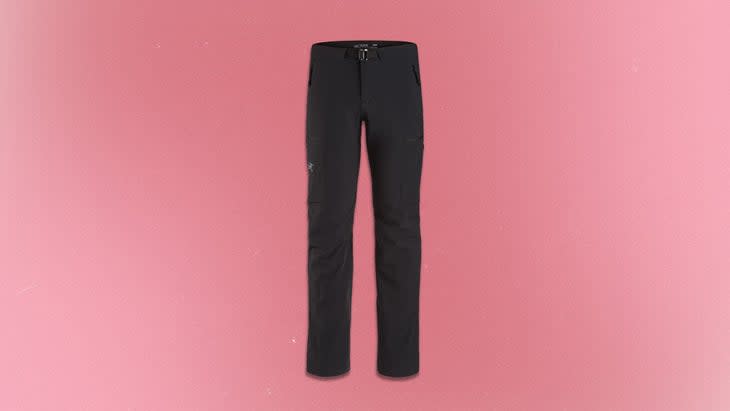
Size range: S-2XL (short and long sizes available)
Once all the rage, in recent years softshell pant offerings have dwindled in the outdoor market. We can't help but feel disappointed. Sure, they're not fully waterproof, and are a bit heavier than their hardshell counterparts; but their warmth, breathability, mobility, and durability make them superior for ice cragging and single-day endeavors. Luckily, Arc'teryx has chosen to keep their softshell line alive with updates and improvements to features and fabric. The Gamma MX Pants have a trim cut to help you execute fancy footwork and avoid crampon catches, with enough stretch to high step and stem without restriction. Between their DWR treatment, breathability, and quick-drying nature, these pants finished long days in Cody and Hyalite Canyon as dry as they began. The thin, fleecy lining also provides enough warmth to negate a baselayer in moderate temperatures, which means better breathability to avoid clamminess during uphill approaches. The updated Fortius 2.0 fabric was strong and resilient to abrasion. However, it did tear a bit more with the inevitable crampon point catch than past versions of softshells we've used (though it's easy to slap a repair patch on). In that sense, it performed like a midpoint between a softshell and hardshell.
Best-for: A simple, sleek softshell pant for cold escarpments
Zeal Optics Auto Sun Collection ($229)
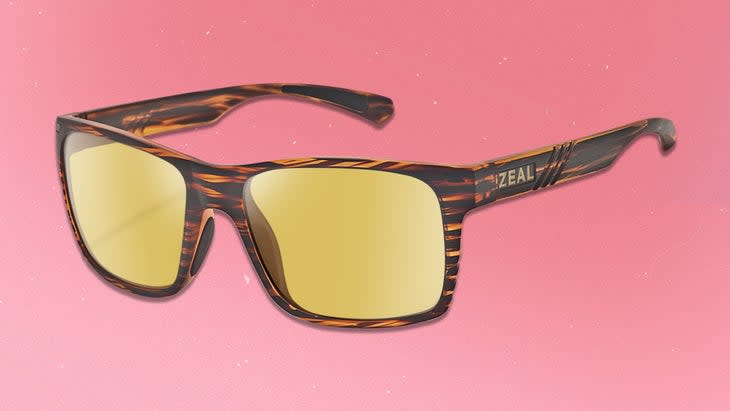
Size range: 10 frame styles & sizes
A few scares we had this season demonstrated just how critical our Zeal sunglasses were in our ice climbing quiver. First, our lead tester nearly got swept off an Alaskan peak by a sluff avalanche that took his Zeal Brewer sunglasses for a ride. Luckily, his partner 100 feet below caught them; but in just those few minutes, the bright sun and snow reflection were literally blinding. Secondly, a mutual friend left his eyes exposed on Denali and actually frostbit an eyeball. Eyes are precious. Invest in a quality pair like these that fit and perform well, and they'll be more likely to get worn.
Zeal's Auto Sun collection features polarized lenses that automatically adjust their shading from 28-15 percent so you don't have to swap them repeatedly as conditions change. This is quite handy for activities that beg eye protection even when it’s shady out, like ice climbing and mountain biking. The real kicker for us: Zeal just expanded their variable lens availability to a variety of stylish and understated frames that don't have you looking like a European mountain guide or fresh off the peloton. Plus, all Zeal frames are made from Z-Resin: a plant based material (i.e. not petroleum) that's biodegradable in the long term.
Best-for: Protecting your eyesight without looking like a Rapha acolyte.
How To Buy
Ice climbing is the most gear intensive, and therefore expensive, iteration of climbing. It's also the most location and condition specific. So, it’s no surprise that it remains the most niche. But with that comes an allure to buy everything. If you're starting out, we recommend being conservative on how much you spend before you know exactly what you're looking for--much like a $200 pair of rock shoes is unnecessary for a beginner. Secondhand gear will give you a feel for the sport and your preferences before you throw down thousands on a fancy new kit. Check out online forums like MountainProject.com and eBay, or even your local Facebook Marketplace.
For those ready to dive in on new gear, boots are a number one spending priority. Take care of your feet--you can't get anywhere without them. Most modern tools and crampons will last for years, which means used pairs perform like new with a fresh set of picks or frontpoints. But boots wear out and a nice, new pair suited to your fit will deliver the most bang-for-your-buck. Head to a local shop that knows the sport to get a well-fitting pair, and repay their expertise with a purchase. From there you can begin to accumulate hard goods like ice tools, crampons, and ice screws. Most ropes, draws, and harnesses can cover the gamut from rock to ice if purchased with versatility in mind.
For exclusive access to all of our fitness, gear, adventure, and travel stories, plus discounts on trips, events, and gear, sign up for Outside+ today.

